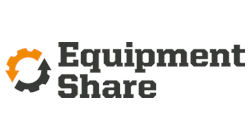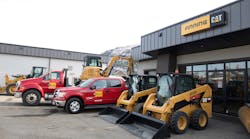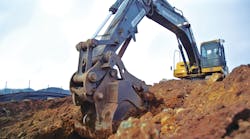Think about the rental process from the customer’s point of view. He wants the equipment for the project, he wants the relevant accessories for the job, he wants a reasonable price, and he wants it to be ready exactly when he wants it, whether it’s delivered or he’s going to pick it up. Few things upset a customer more than the item not being there when he needs it. And of course, he expects to be billed accurately.
If your rental company can figure out how to do those things online, reserving and renting equipment online will work. And however much they want to make it all digital, and make the phone call obsolete, the telephone better be working if something goes wrong. Because however digital that customer wants to be, if the equipment isn’t delivered on time, or he can’t figure out how to work it or it doesn’t appear to be functioning properly, or if it breaks down on the job, the customer doesn’t want to go to a website. He wants to make a call, have a real live human being answer the phone, and be able to know what he’s talking about and respond to the question or problem immediately. Immediately because while he might be a great customer, his temperature is probably already rising.
That’s when the human element has to come in or that transaction is doomed, and the customer is not likely to want to repeat. There is probably no computer software that can apologize, let the customer know it knows exactly how he feels, and then patiently, step by step, guide him through the next steps. At that point, the skillful human touch enters the equation and makes or breaks the transaction.
But digital rental is happening, not as fast as retail but it’s increasing.
E-commerce as a percentage of U.S. retail sales went from 4.6 percent to 18 percent from 2010 to 2020, according to one estimate. Which direction do you think it will be by 2030? Maybe 25 percent, maybe 30 or 40 percent. I don’t think it’s likely to level off at that point. More likely it will keep rising and probably a lot faster.
Another article says it grew 5.4 times during the decade of the ’10s, from $1 trillion to $5.4 trillion. A different study might have slightly different numbers, but the essence is going to be the same. And, with time, the pressure to do it will come from customers and competitors, if it hasn’t already.
As Colin Grill, CEO of Aaction Rents, Windsor, Calif., says, much of it is generational. “You’ve got a generational divide between the boomers and the millennials,” he says. “As genex and millennials are more and more of the market it’s going to be a more comfortable way for them to do business. We have to adapt.”
“We see a significant upswing in the number of customers who prefer to manage their equipment rental spend online,” says Guy Manuel, CEO of Stephenson’s Rental Services, Mississauga, Ontario. “It's why we have invested so much into our new customer portal, called EasyLink. It provides our customer base with an unequalled platform to easily manage their projects with the ability to rent, off-rent, or request service on their schedule, not ours! In addition, our telematics, climate monitoring, reporting, and PO management modules bring real value to our customer base.”
To companies that have found success in online renting, it tends to be part of a larger package of services. It’s not just reserving, or just calling off-rent, but it’s part of a larger suite of online services.
“Obviously, the basics of renting, off-renting, and requesting service are the basic table steaks, but making a customer's day-in and day-out activities simple is really crucial,” Manuel says. “We are careful not to overwhelm them, but allow them to customize notifications, their view, and their reporting to focus on what's important to them. Visual dashboards help draw attention to what our customers feel is most important in their project lifecycle. Reducing the amount of paperwork or keystrokes is critical, as is providing complete transparency on how their business with us looks. We are here to help them save time and money.”
Bob Kendall, CEO of Star Rentals, says Star customers don’t actually place orders via the company’s website, but they do inquire about availability and price. However, the actual transaction can only be generated by Star Rentals staff. Most online inquiries, Kendall says, are not regular customers but rather potential opportunities.
“We do not actually track the number of inquiries at this time, but the volume is definitely more than several years ago and growing,” Kendall notes.
However, Star does have a website portal which Kendall calls “an integral component of the customer experience. Being able to track equipment by type, job location, duration and billings is very popular.”
Kendall says the most important online services are electronic billing and customers’ ability to access their accounts through the portal.
“Rental and sales inquiries are more spontaneous and require immediate responses. That is what the customer is looking for when it comes to ordering,” Kendall says.
But the Internet does serve Star as a means of building relationships with potential customers.
“The website is a great tool coupled with the ability for customers to reach out directly about products and pricing then receiving a timely response,” Kendall says. “From our perspective, this is the first step in turning an inquiry into a customer and ultimately maybe a business relationship.”
Current market tailwinds
Some rental companies have been forced by the current marketplace realities to hold off on plans to develop their digital strategies.
“I thought I’d have an online portal by now,” says Grill. “But inflation and scarcity of employees, everything else has kind of slowed things down.”
A few other rental company owners contacted for this story also said they are not sure if they have sufficient staff to devote the attention required to install and manage an e-commerce system.
“My belief is that even with a portal it would create complexities and management that we are not ready for,” says Anthony Durante, executive chairman of Durante Rentals. “My vision is that we think of client portals as all encompassing (book, call off, payment, etc.)”
Obviously larger rental companies have more budget, management infrastructure and staff to set up the system and make sure the details are operating smoothly.
“Customers are looking for ways to optimize efficiencies and transacting digitally has become an avenue to do just that,” says Paul Maddison, director of digital innovation, United Rentals. “For a lot of transactions, e-commerce makes sense, and customers have come to rely on the convenience of online channels. Capabilities such as access to your complete rental history, the ability to click a button to repeat an entire order, the ability to set up plus save jobsite and payment information mean complex orders can be made digitally in only a few clicks. Rental websites are also a source of knowledge. Industry guides, detailed equipment specification, operational instructions, case studies and safety guides mean people can ensure they choose the right solutions and equipment for the job.”
“With the development of Navigator, Sunstate wanted to do more than simplify use, display rental information, and provide online access to directly manage rental activity,” says Josh Curtis, director of marketing for Sunstate Equipment Rental, referring to Sunstate’s online system. “We sought to create a digital projection of our business philosophy to be transparent and measure how we perform for our customers. To embolden those business principles, we created metrics to measure billing and delivery accuracy, as well as service and equipment uptime that are available online to every customer. Sunstate harnesses 45 years of knowledge and experience as one company in the rental industry to provide our customers with a powerful online tool to empower self-service, while also ready to pick up the phone and provide local support anytime.”
Curtis says online ordering has grown steadily during the past seven years since Sunstate launched it and accelerated significantly since the pandemic.
“The combined effect of releasing Navigator during the pandemic grew customer use of online rental management from less than 10 percent of customers prior to the pandemic to over 50 percent today,” he says. “Customers continue to utilize more and more features built within Navigator and we expect that trend to continue.”
“Online retail companies have set the experience and expectation for customers, we now need to adopt advancements in technology and apply this online service to our industry,” says Lance Renzulli of High Reach Co., Sanford, Fla. “Prior to the pandemic we launched a new website that was mobile friendly and within the first three months we noticed a major increase in parts orders, requests for rentals and machine sales. Within one month we had three times more activity online than we did in one year on our previous website.”
Supplying the e-commerce experience
Most software providers to the rental industry offer a suite of e-commerce services. For some rental companies, use of these services will involve significant adaptation to fit with their telematics systems and their point of sale and management systems. For others, it’s more plug-and-play. But software is rarely that simple – it usually requires some adaptation and integration.
RER spoke with some of the leading suppliers of rental software to see what they offer to facilitate e-commerce systems that rental companies can use to enhance the online experience for their customers.
“Our e-commerce solution is providing three main functions: One, it’s a complete shopping cart to reserve equipment or buy sales items with all the best features to search, add to the cart and checkout options to pay online,” says Patrice Boivin, CEO of Orion Software. “It’s a complete web portal for clients to follow up their current contracts, sign their quotes, view delivery trucks in real-time on a map, request for maintenance onsite, or return and access statement of accounts. It’s a rental and sales solution for the sales force to reserve and manage all transactions with a complete CRM. It’s all on the same mobile app or web site.”
Boivin adds that the company’s web portal provides availability and specific rates by branch, the specifications of the equipment along with documents for operating the equipment, videos or links to manufacturers.
“A few years ago, e-commerce felt like something that only the large corporate rental companies needed to worry about,” says Matt Hopp of InTempo Software. “However, as more local and regional organizations are getting on board, it’s becoming a ‘must-have’ rather than a ’one day we’ll get to this’ idea. Getting started with e-commerce can feel like such a big project that companies want to wait just a little bit longer before adopting it. However, everyone has to start somewhere; even a basic setup is a step in the right direction.
“We recommend choosing an e-commerce platform that can grow alongside you - first with basic inventory and checkout capabilities, then with a full, robust integration with your base rental software. From there, you can layer in reporting, online advertising, and other ‘extras’ once you’ve got the basics in place.”
Point of Rental Software offers a few different software products, all of which can adapt to e-commerce.
“Point of Rental handles all of the e-commerce tasks [used in rental],” says Caleb Yell, e-commerce manager, Point of Rental Software. “It may handle them differently depending on the product. All of our products allow rental stores to take reservations (or only take quotes if you prefer) and see availability over any requested dates. Regarding availability across locations, customers using Elite or Syrinx can choose a location and the software will notify the rental counter to create transfer orders; for people that work with rental stores, that’s typically the best workflow. Essentials Enterprise customers -- basically, retail outlets who offer rental as a part of the rest of their services -- are able to see all store locations and identify available assets at different locations, because their customers tend to be searching for more last-minute, small-item inventory.”
Point-of-Rental’s portal enables rental customers to initiate calls off rent, and capture condition photos. “With telematics integrations, we can also track GPS machine location data in the customer portal for easy location on large job sites,” adds Yell. “We’re currently working on an API to work with our telematics partners to allow onboard telematics devices to provide additional information on utilization, required maintenance, and more.”
Order to cash
Wynne Systems has been one of the most popular software providers for larger companies, from industry pace-setter United Rentals on down.
“Wynne System’s RentalMan suite has two e-commerce solutions available for rental companies - RenterLink and Customer Portal,” says Ryan Helmeid, product marketing specialist, Wynne Systems. “When combined, they go beyond the typical e-commerce solution to provide rental companies with the ability to manage the entire order to cash process through a digital means. This means the solution isn’t just limited to advertising equipment and taking orders and reservations. It can also handle a variety of different parts of this process like showing payment terms, sending invoices, taking payments, and more.
“Much of this order to cash process in the rental industry has the same challenges. Rental companies and customers are often limited to phone calls, emails, or in-person communication to accomplish many parts of this process. These forms of communication can take a lot of time and effort, sometimes affecting customer relationships and ultimately costing the rental company. Wynne’s e-commerce platform and additional suite of solutions cut through these challenges. Equipment reservations go directly to the rental counter for processing. This process flow ensures that reservations can be fulfilled as soon as the order is made.”
When it comes to customer portal, the rental company still controls how much it wants to communicate with the rental customer about the availability of its inventory.
“While we find that many rental companies will typically show equipment as available and figure out how to source it later, the platform offers flexibility in this area,” Helmeid adds. “The solution connects directly with your RentalMan database, which provides real-time data flow back to the e-commerce platform. The flexibility of Wynne’s solutions means that rental companies can configure their equipment availability on the e-commerce platform however they would like it. If a customer would like it to simply show as out of stock, the platform can handle that. If they’d like it to remain available, even if there are none available at the branch but they plan to run a quick branch transfer or re-rent, that option is available as well. This flexibility gives rental companies the options they need to run their business how they see fit.”
The inside sales staff shouldn’t have to make a lot of phone calls to find out if there are appropriate units available.
“After a reservation comes into the rental branch, the coordinator has full visibility into the inventory of not just their branch, but other branches as well,” Helmeid says. “If equipment is not available at their location, they can easily arrange for transfers to fulfill customer requests.”
Texada also offers what it calls a complete self-service solution that can be configured by its clients for their customers.
“Customers can make reservations, browse all equipment on offer, and see rates for rentals, which includes special pricing if they’re logged in,” says Adam Kropf, head of product and development, Texada. “In addition, they can see their account history and pay invoices online, as well as get automated alerts for the equipment they have on rent.”
Becoming the standard
Kropf strongly believes e-commerce systems will become standard in the industry sooner than later and will increasingly be a necessity to compete effectively.
“Companies should be prepared to give everyone on their team access to their systems to enable sales and services faster,” he adds. “Everyone should also be ready to go completely paperless, since paper is too slow to keep up with demands, especially as companies will be expected to service more customers with a leaner team.
“Rental companies should be preparing to keep up with an increasingly digital world by adopting fully integrated systems that allow them to bring as many aspects of their business online as possible, from inventory and e-commerce to accounting to sales, support and services. Phasing out paper in favor of digitization and automation will allow companies to be leaner, more responsive, and more cost-efficient in a world where customers are looking for instant service and great value for their money.”
Alert Rental Software has three separate modules that can handle e-Commerce, explains Alert Rental co-president/CEO Kara Longmire. “The first is Web Services,” she says. “With Web Services, the Alert system is connected to the rental website and the end customer can browse inventory and put items in a shopping cart. When they request an order, the order details appear in Alert and the salesperson can then complete the order. This is our most popular e-commerce solution because oftentimes a rental customer doesn’t know exactly what they want. (i.e. everyone wants a backhoe when a mini-excavator will do the job!)
“Another popular feature is Customer Portal, where the end customer can log on to their account to self-service their billing, make payments, download invoices, and call items off rent. We also have an e-commerce module that allows the end customer to complete a reservation from start to finish. We work with the rental store to ensure that only the customers they permit are able to complete a reservation from start to finish. With the e-commerce module, yes, end users can see availability and make their reservations based on that information.”
Longmire explains the most important benefits of e-commerce.
“It’s all about reducing friction with the end customer. We want Alert users to be able to easily conduct business with their own clients, and our suite of web services help them achieve a professional and seamless experience. Beginning with the website, renters are able to view inventory, place orders, and in some cases complete an entire reservation. Renters can also make payments and self-service their own accounts without having to contact the store to discuss open invoices. With Sign & Rent, end renters can accept bids, make deposits, and receive equipment. All of these enhancements help our rental stores save touch costs and reduce friction with their own customers.”
Ultimately a rental company can have the most sophisticated online system or not have one at all, but it’s all about serving the customer. And there’s no doubt that fast-moving, time-saving systems will be the way of doing business going into the future.
And the customer base will keep getting younger. Or, more accurately stated, people who are younger now will be determining online practices far into the future and rental companies, whether they like it or not, will have to make it easier for them and do business the way they are most comfortable. Look to the youngest people in your company and see the way they shop and how they like to communicate, because that will be the future, in the 2020s and 2030s. The world is becoming more digital and we all will have to adapt.








